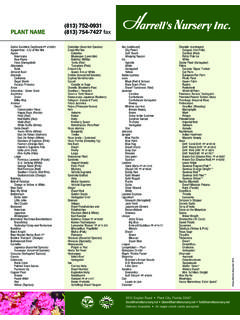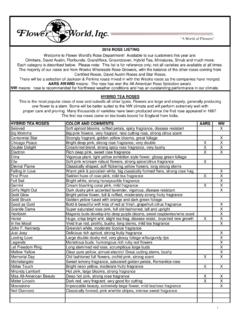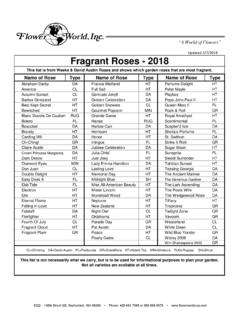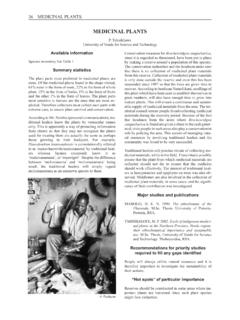Transcription of Verticillium Wilt of Vegetables and Herbaceous …
1 Dr. Sharon M. Douglas Department of Plant Pathology and Ecology The Connecticut Agricultural Experiment Station 123 Huntington Street, P. O. Box 1106. New Haven, CT 06504. Phone: (203) 974-8601. Fax: (203) 974-8502. Founded in 1875 Email: Putting science to work for society Website: Verticillium WILT OF Vegetables AND Herbaceous . ORNAMENTALS. Verticillium wilt is a disease of over 300 SYMPTOMS AND DISEASE. species throughout the United States. This DEVELOPMENT: includes a wide variety of Vegetables and Symptoms of Verticillium wilt vary by host Herbaceous ornamentals. Tomatoes, and environmental conditions. In many eggplants, peppers, potatoes, dahlia, cases, symptoms do not develop until the impatiens, and snapdragon are among the plant is bearing flowers or fruit or after hosts of this disease. Plants weakened by periods of stressful hot, dry weather. Older root damage from drought, waterlogged leaves are usually the first to develop soils, and other environmental stresses are symptoms, which include yellowing, thought to be more prone to infection.
2 Wilting, and eventually dying and dropping from the plant. Infected leaves can also Since Verticillium wilt is a common disease, develop pale yellow blotches on the lower breeding programs have contributed many leaves (Figure 1) and necrotic, V-shaped varieties or cultivars of plants with genetic lesions at the tips of the leaves. resistance this has significantly reduced the prevalence of this disease on many plants, especially on Vegetables . However, the recent interest in planting heirloom . varieties, which do not carry resistance genes, has resulted in increased incidence of Verticillium wilt on these hosts. Verticillium wilt is caused by two closely related soilborne fungi, Verticillium dahliae and V. albo-atrum. Isolates of these fungi vary in host range, pathogenicity, and virulence. Verticillium species are found worldwide in cultivated soils. Figure 1. Yellow blotches on lower leaves of eggplant infected with Verticillium wilt.
3 As the disease progresses, younger leaves begin to wilt and die until healthy leaves are only visible at the top of the plant. Symptoms often appear one-sided, developing on half of a leaf (Figure 2), on half of a leaflet of a compound leaf (Figure 3), or on half of a plant. Figure 4. Pepper with irreversible symptoms of Verticillium wilt. Figure 2. Verticillium -infected eggplant with leaves exhibiting symptoms on half of each leaf. Figure 5. Field of eggplant with symptoms of Verticillium wilt. A diagnostic characteristic of Verticillium wilt is distinctive discoloration or streaking in the vascular system. When the stem is cut in cross-section, the ring of vascular tissue is Figure 3. Tomato leaflet with symptoms on brown and the pith remains white. This half of a leaflet. discoloration is also visible with longitudinal cuts (Figure 6). Discoloration Highly susceptible plants wilt and die can also occur in roots and tubers (Figure 7).
4 Shortly after initial symptoms appear but usually does not occur in the leaf (Figures 4 and 5). In contrast, although petioles. Since the discoloration of the some plants can be infected with vascular system is almost identical to that Verticillium wilt, they are not killed but are associated with Fusarium wilt, positive stunted and weak and produce undersized diagnosis of Verticillium wilt requires flowers or fruit, depending on the host. culturing tissues in the laboratory. Verticillium Wilt of Vegetables and Herbaceous Ornamentals S. M. Douglas 2. The Connecticut Agricultural Experiment Station ( ). specialized hyphae (phialides) in a whorl around a conidiophore. Verticillium is named for this verticillate or whorled arrangement of the phialides on the conidiophore (Figure 8). The presence of the fungus in the xylem restricts movement of water and nutrients by its physical presence as well as through production of enzymes and toxins.
5 As the fungus grows in the xylem, the plant responds in both physical and biochemical ways to contain or compartmentalize the fungus. This results in plugging and gumming of water- conducting vessels, which further restricts water in the host. Figure 6. Characteristic discoloration in xylem of Verticillium -infected eggplant. Figure 8. Verticillate spore-bearing structures on conidiophores. As more vessels are plugged and collapse, the water supply to the leaves is blocked. In the early stages of infection, plants wilt after Figure 7. Discoloration in the vascular a hot, sunny day and recover at night. As the tissues of potato tubers of a plant infected disease progresses, the wilt becomes with Verticillium wilt. irreversible. Verticillium species are soilborne and persist Verticillium wilt also occurs on a wide for indefinite periods of time in the soil as range of woody and Herbaceous hosts. The resting structures called microsclerotia.
6 Fact sheet Verticillium Wilt of Ornamental Germination and growth of these structures Trees and Shrubs has more information on is stimulated by exudates from a host plant the effects of the disease on woody hosts. or from decaying organic matter. The fungus enters the roots and the water transport system (xylem) of the plant. It MANAGEMENT STRATEGIES: then grows, sporulates, and moves Managing Verticillium wilt is most systemically throughout the plant. Spores successful using a multifaceted strategy. (conidia) are ovoid and are borne on There are no satisfactory controls for this disease once plants are infected. Verticillium Wilt of Vegetables and Herbaceous Ornamentals S. M. Douglas 3. The Connecticut Agricultural Experiment Station ( ). Fungicides are not effective for control. Vegetables with genetic resistance are in For plants that exhibit mild symptoms, it Table 3. can help to maintain vigor by following Long rotations of four to five years with sound cultural practices.
7 These include non-related crops can be helpful but are watering during periods of drought and not usually feasible in home gardens. fertilizing (based on a soil test). Since microsclerotia can be present in Mulching is also beneficial since it helps soil or debris, it is important to avoid maintain soil moisture and moderate soil moving soil or debris from areas of temperatures. Although infected plants known infection. cannot be cured, these practices can Weed control is helpful since the fungus sometimes delay the progression of the can infect a variety of common weeds disease until the crop can be harvested. such as ragweed, cocklebur, and Verticillium fungi can survive for many velvetleaf. years as microsclerotia in the soil. As a precaution against spread, all tools Therefore, it is necessary to avoid should be disinfested between cuts with planting susceptible species in areas a 10% solution of household bleach, known to be infested.
8 In these cases, 70% alcohol, or one of the commercial resistant or immune species should be products such as Physan 20. planted (Tables 1 and 2). Lists of specific varieties or cultivars of common Verticillium Wilt of Vegetables and Herbaceous Ornamentals S. M. Douglas 4. The Connecticut Agricultural Experiment Station ( ). Table 1. Resistance of Selected Herbaceous Ornamentals to Verticillium Wilt. Susceptible Resistant or Immune African daisy (Arctotis spp.) Ageratum (Ageratum spp.). Aster (Aster spp.) Alyssum (Alyssum spp.). Belladonna (Atropa belladonna) Anemone (Anemone spp.). Bellflower (Campanula spp.) Baby's breath (Gypsophila paniculata). Black-eyed Susan (Rudbeckia hirta) Balloon flower (Platycodon grandiflorum). Blue sage (Salvia azurea var. grandiflora) Browallia (Browallia spp.). Butterfly flower (Schizanthus pinnatus) Calendula, pot marigold (Calendula officinalis). Cape marigold (Dimorphotheca sinuata) Candytuft (Iberis spp.)
9 China aster (Callistephus chinensis) Christmas rose (Helleborus niger). Chinese lantern plant (Physalis alkekengi) Cleome (Cleome spp.). Chrysanthemum (Chrysanthemum spp.) Columbine (Aquilegia spp.). Cockscomb (Celosia argentea var. cristata) Coral bells (Heuchera sanguinea). Dahlia (Dahlia variabilis) English daisy (Bellis perennis). Foxglove (Digitalis purpurea) Evening primrose (Oenothera spp.). Garden balsam (Impatiens balsamina) Gaillardia (Gaillardia spp.). Gayfeather (Liatris spp.) Geum (Geum spp.). Geranium (Pelargonium x hortorum) Hollyhock (Althaea rosea). Heliotrope (Heliotropium arborescens) Honesty, silver dollar (Lunaria annua). Jacob's ladder (Polemonium spp.) Impatiens (Impatiens sultani). Lobelia (Lobelia erinus) Lantana (Lantana spp.). Oriental poppy (Papaver orientale) Monkey flower (Mimulus spp.). Pelargonium (Pelargonium x domesticum) Moss rose (Portulaca grandiflora). Peony (Paeonia spp.) Nasturtium (Tropaeolum majus).
10 Petunia (Petunia hybrida) Nemesia (Nemesia strumosa). Phlox (Phlox spp.) Pansy, viola, violet (Viola spp.). Rocket larkspur (Delphinium ajacis) Penstemon (Penstemon spp.). Sage (Salvia haematodes) Periwinkle (Vinca minor). Shasta daisy (Leucanthemum x superbum) Persian buttercup (Ranunculus asiaticus). Snapdragon (Antirrhinum majus) Pinks, sweet William (Dianthus spp.). Stock (Matthiola incana) Potentilla (Potentilla spp.). Strawflower (Bracteantha bracteata) Primrose (Primula spp.). Sweet pea (Lathyrus odoratus) Scabiosa, sweet scabious (Scabiosa Tickseed (Coreopsis lanceolata) atropurpurea). Transvaal daisy (Gerbera jamesonii) Sunflower (Helianthus spp.). Tuberous begonia (Begonia tuberhybrida). Verbena (Verbena x hybrida). Wallflower (Cheiranthus cheiri). Wax begonia (Begonia semperflorens). Wishbone plant (Torenia fournieri). Zinnia (Zinnia spp.). Verticillium Wilt of Vegetables and Herbaceous Ornamentals S. M. Douglas 5.















